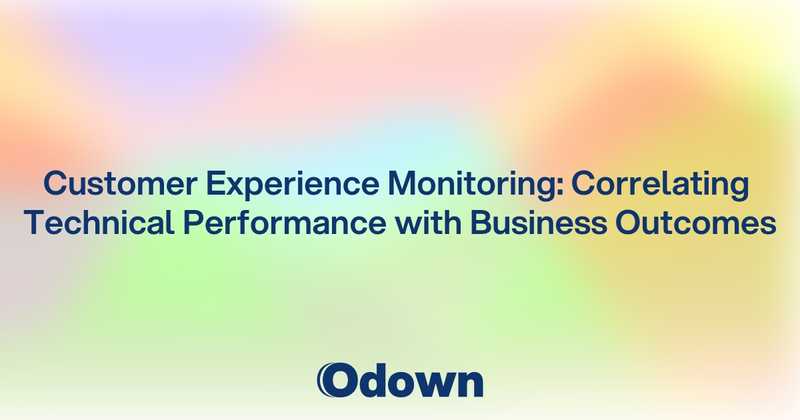Customer Experience Monitoring: Correlating Technical Performance with Business Outcomes
Your website's average response time increased by just 200 milliseconds last month, but your conversion rate dropped by 15% and customer complaints spiked. Your SaaS platform shows 99.9% uptime, yet customer satisfaction scores are declining and subscription renewals are below target. Your e-commerce site handles Black Friday traffic without crashing, but abandoned cart rates suggest customers are still having poor experiences that don't show up in traditional monitoring.
Technical performance monitoring tells you what's happening to your systems, but it doesn't explain what's happening to your business. The gap between technical metrics and business outcomes leaves organizations blind to how performance problems actually affect revenue, customer satisfaction, and long-term growth.
Understanding the correlation between technical performance and business metrics helps organizations prioritize improvements based on actual customer impact rather than theoretical technical problems. A 500ms delay might be acceptable for internal tools but devastating for e-commerce checkout flows.
Reliable monitoring platforms provide the performance data needed for correlation analysis, but extracting business insights requires combining technical metrics with customer behavior data, satisfaction surveys, and business outcomes. The goal isn't just fast systems---it's systems that drive business success.
Performance Impact on Customer Satisfaction: Data-Driven Correlation Analysis
The relationship between technical performance and customer satisfaction is more complex than most organizations realize, requiring sophisticated analysis to identify meaningful correlations.
Page Load Time and User Behavior Correlation
Website performance affects user behavior in measurable ways that impact business outcomes:
Bounce rate correlation with load times reveals how quickly users abandon pages based on performance. Studies consistently show that bounce rates increase dramatically when page load times exceed 3-4 seconds, but the exact threshold varies by industry and user expectations.
Session duration impact analysis measures how performance affects how long users spend on websites and applications. Slow performance often causes users to spend less time exploring products or content, directly affecting engagement and conversion opportunities.
Page views per session correlation tracks how performance affects user engagement depth. Users experiencing slow performance typically view fewer pages and explore less content, reducing opportunities for conversion and engagement.
Mobile vs Desktop Performance Impact
Different device types have different performance expectations that affect customer satisfaction:
Mobile performance tolerance analysis reveals that mobile users often have lower performance tolerance than desktop users, despite typically having slower connections. Mobile users expect fast performance and are more likely to abandon slow experiences.
Network condition impact assessment measures how performance degrades under different connection types and how users respond. Users on slower connections might be more tolerant of delays, but poor optimization can still cause abandonment.
Device-specific satisfaction correlation tracks how performance affects satisfaction differently across smartphones, tablets, and desktop computers. Device capabilities and user context affect performance expectations and satisfaction levels.
Geographic and Demographic Performance Impact
Performance impact varies significantly across different user groups:
Regional performance variation analysis reveals how geographic location affects both technical performance and user satisfaction. Users in different regions might have different performance expectations based on local internet infrastructure.
Demographic satisfaction correlation tracks how performance affects different age groups, income levels, and technical sophistication segments. Different user groups have different performance expectations and tolerance levels.
Cultural performance expectations assessment recognizes that performance tolerance varies across different cultures and markets. International businesses must understand local performance expectations to optimize customer satisfaction.
Revenue Impact of Downtime: E-commerce and SaaS Business Case Studies
Different business models experience downtime and performance issues differently, requiring industry-specific approaches to measuring financial impact.
E-commerce Revenue Impact Analysis
Online retail businesses face immediate and measurable revenue impact from performance problems:
Conversion rate correlation with performance tracks how website speed affects the percentage of visitors who make purchases. E-commerce conversion rates typically decline significantly when page load times exceed 2-3 seconds, with mobile users showing even higher sensitivity.
Average order value impact measurement reveals how performance affects purchase behavior. Slow checkout processes often cause customers to reduce order sizes or abandon purchases entirely, affecting both conversion rates and revenue per customer.
Peak traffic performance impact analysis is particularly important for e-commerce businesses during sales events, holidays, and promotional campaigns. Performance problems during high-traffic periods can cause disproportionate revenue losses.
SaaS and Subscription Business Impact
Software-as-a-Service businesses face different challenges where performance affects long-term subscription value:
Trial conversion correlation with reliability measures how performance during trial periods affects paid subscription conversion rates. Poor performance during trials can prevent users from understanding product value and reduce conversion rates significantly.
Feature adoption impact analysis tracks how performance affects user engagement with different product features. Slow feature performance can reduce adoption and make products less valuable to customers, affecting retention and expansion revenue.
Customer support ticket correlation reveals how performance problems generate support costs and affect customer satisfaction. Performance-related support tickets often cost more to resolve and create negative customer experiences.
B2B vs B2C Impact Differences
Business and consumer customers have different tolerances and expectations for performance:
Enterprise customer tolerance analysis shows that business customers often have higher reliability expectations and less tolerance for performance problems that affect productivity. Enterprise customers also typically have more alternatives and switching power.
Consumer behavior pattern analysis reveals that individual consumers might be more tolerant of occasional issues but less forgiving of consistent problems. Consumer satisfaction is often more emotional and influenced by perception than objective performance measurements.
Contract and SLA impact assessment tracks how performance problems affect business relationships and contractual obligations. B2B performance problems can trigger SLA penalties and contract renegotiations.
Customer Retention and Technical Reliability: Long-Term Relationship Analysis
Technical reliability affects customer retention in ways that aren't always immediately obvious, requiring long-term analysis to understand relationship patterns.
Reliability and Churn Correlation
Customer churn often correlates with technical reliability, but the relationship can be complex and delayed:
Cumulative reliability impact tracking measures how repeated performance issues affect customer loyalty over time. Individual incidents might not cause immediate churn, but accumulated frustration often leads to eventual customer departure.
Performance problem recency analysis shows that recent performance issues have more impact on retention than historical problems. Customers often forgive past issues if current performance is good, but recent problems strongly influence retention decisions.
Churn prediction model integration incorporates technical performance metrics into customer retention prediction models. Performance data can significantly improve churn prediction accuracy when combined with usage and engagement metrics.
Long-term Value Impact Assessment
Technical reliability affects customer lifetime value in ways that extend beyond immediate revenue:
Customer lifetime value correlation with reliability tracks how performance affects the total value customers provide over their entire relationship. Reliable performance often correlates with longer customer relationships and higher lifetime value.
Expansion revenue impact analysis measures how performance affects customer willingness to purchase additional products or upgrade service levels. Poor performance can prevent customers from expanding their relationship even when they don't churn.
Referral and word-of-mouth impact tracking reveals how performance affects customer advocacy and organic growth. Satisfied customers with good performance experiences are more likely to refer new customers.
Retention Intervention Strategies
Understanding performance-retention correlation enables proactive retention strategies:
Early warning system development uses performance metrics to identify customers at risk of churning due to poor experiences. Early identification enables proactive outreach and problem resolution.
Performance-based customer success initiatives prioritize support and improvement efforts for customers experiencing performance problems. Targeted interventions can prevent churn and improve satisfaction.
Reliability communication strategy development helps organizations communicate with customers about performance improvements and problem resolution. Transparent communication can improve customer perception even when technical problems occur.
Net Promoter Score (NPS) and Performance Correlation: Building Customer Loyalty
Net Promoter Score provides a standardized metric for measuring customer loyalty that can be correlated with technical performance data.
NPS and Performance Metric Correlation
Understanding how technical performance affects customer advocacy helps prioritize improvement efforts:
Response time correlation with NPS reveals how website and application performance affects customer willingness to recommend products or services. Performance improvements often provide measurable NPS increases.
Uptime correlation analysis tracks how service availability affects customer advocacy. Even brief outages can significantly impact NPS scores, particularly for business-critical applications.
Error rate impact on customer advocacy measures how application errors and failures affect customer satisfaction and recommendation likelihood. Error-free experiences typically correlate with higher NPS scores.
Segmented NPS Analysis
Different customer segments respond differently to performance issues:
Power user vs casual user NPS correlation shows that frequent users often have higher performance expectations and show stronger correlation between performance and advocacy. Power users can become strong advocates when performance meets their needs.
Customer tenure impact analysis reveals how performance affects NPS differently for new versus established customers. Long-term customers might be more forgiving of occasional issues but also have higher overall expectations.
Industry-specific NPS correlation recognizes that performance expectations vary significantly across different industries and use cases. Mission-critical applications require higher performance standards than casual-use applications.
NPS Improvement Strategy Development
Understanding performance-NPS correlation enables targeted improvement strategies:
Performance improvement prioritization uses NPS correlation data to identify which technical improvements will have the most impact on customer advocacy. ROI analysis helps prioritize technical investments based on customer impact.
Customer feedback integration combines NPS surveys with performance monitoring to provide comprehensive insights into customer experience. Integrated feedback helps identify performance issues that customers care about most.
Advocacy program development leverages performance improvements to build customer advocacy programs. Customers experiencing excellent performance are more likely to participate in case studies, references, and word-of-mouth marketing.
Effective customer experience correlation requires combining technical monitoring with business intelligence and customer feedback systems. Digital transformation monitoring strategies provide frameworks for integrating performance monitoring with broader business transformation initiatives.
Ready to understand how your website performance affects customer satisfaction and business outcomes? Use Odown to monitor the uptime and performance metrics that directly impact customer experience, enabling data-driven decisions that improve both technical reliability and business results.



